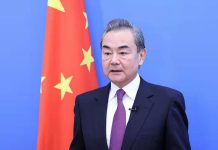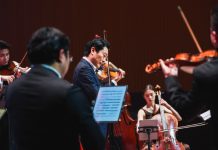
Stepping onto the highest Paralympic podium has been a dream cherished by Chinese standing skier Zhang Mengqiu, despite not learning to ski until she was 14.
Zhang is not a quick learner. Being diagnosed with cerebral palsy in childhood, she suffers from impaired motor function. It usually takes her two or three times longer than her able-bodied peers to master new skills. But the intense training regimen has paid off. The 20-year-old has blossomed into one of the top para skiers in the world.
Prior to the Beijing 2022 Winter Paralympics, Zhang had already pocketed six gold medals in international competitions, including at the World Para Alpine Skiing World Cups. She is competing in the slalom, giant slalom, super giant slalom and super combined at the Games.
China has just delivered a wonderful Olympic Winter Games, and it has pledged to host an equally splendid Paralympic edition from March 4 to 13. “We are very excited to see the fantastic Olympic Games, and China and Beijing 2022 will have the capacity for the Paralympic Games as well,” Andrew Parsons, President of the International Paralympic Committee, told Xinhua News Agency.
Unyielding spirit
The 2022 Winter Paralympics are hosting more than 600 athletes from across the world, and each of them has overcome disabilities and difficulties to achieve excellence in their respective sports.
The Chinese wheelchair curling team, led by 32-year-old captain Wang Haitao, is striving to defend the country’s first-ever Winter Paralympic title, won by the team four years ago in Pyeongchang, the Republic of Korea.
Born in a small village in Heilongjiang Province, Wang’s legs became paralyzed at the age of 9 due to myelitis, an inflammatory disorder of the spinal cord. He began engaging in track and field events after watching parasport competitions on television, and shifted to wheelchair curling in 2008. Beijing 2022 is his third Winter Paralympics.
Wheelchair curling is played with the same stones and on the same ice as regular curling, though the stones are thrown, sometimes with a handle, from a stationary wheelchair and there is no sweeping.
The sport was introduced to the Winter Paralympics in 2006, and Canada had remained the most successful Paralympic team until China’s win in Pyeongchang. After that, China also came in first at the 2021 World Championships.
“Compared with regular curling, it is more difficult for wheelchair curlers to control the path of the stones,” Wang explained. “A simple movement needs be practiced tens of thousands of times.”
Snowboarder Ji Lijia, 19, has also been chasing his Paralympic dream with an eye on the podium. Ji lost his left hand at the age of 5 in an accident with an industrial mixer. He began snowboarding in 2016 when he was 14, and had topped the world para snowboard rankings for 14 consecutive months until February 2021. Around three months later, he returned to share the top spot with Italy’s Jacopo Luchini.
Li Hongguan is a member of the Chinese wheelchair ice hockey team. This is their first Winter Paralympics. Li said the results are not their No.1 goal; more importantly, the team would like to demonstrate their persistence in pursuing excellence.
“Paralympic ice hockey is a high-intensity sport. What it brings me is a brave heart, so when encountering any difficulty, danger or hardship in life, I can overcome it,” Li told state broadcaster China Central Television (CCTV) in an interview ahead of the Beijing 2022 Games.
Li lost his left leg in a car accident when he was 6. He was selected for the national ice hockey team in 2019, and is known for being hardworking.
Para skier Liu Sitong said she was inspired to take up sport by the athletes competing at the Beijing 2008 Summer Paralympics. “They gave me the belief that people with disabilities do not have to live a restrained life. You can enjoy something you love doing, and you can realize your own dreams. So I wanted to try,” she told CCTV.
Liu said she feels proud to be able to take part in the Beijing 2022 Games, and she hopes that her battle against misfortunes and setbacks will inspire more people with disabilities to integrate into society and lead a wonderful life.
Making change
China made its Winter Paralympic debut at the 2002 Games in Salt Lake City, the U.S. Eight years ago, at the Sochi Winter Paralympics, Chinese athletes competed in only six events in two sports. In Pyeongchang, their participation expanded to 30 events in five sports.
Team China to the Beijing 2022 Games has 96 athletes, including 85 first-time Paralympians. They are competing in 73 out of the 78 events in all six Paralympic sports. This is the sixth Winter Paralympics for China, and the one with its largest ever presence.
“China has made great efforts to boost winter parasports. Since 2016, the number of Chinese winter para athletes has increased from 50 to approximately 1,000. Their performance has also improved,” Yong Zhijun, Deputy Director of the Sports Department of the China Disabled Persons’ Federation (CDPF), said.
If Beijing had not won its bid to host the Winter Paralympics, Yan Wendi, an athlete from the tropical part of Yunnan Province in China’s warm southwest, would never have considered partaking in ice and snow sports. Yan has an artificial left leg. His disability used to make him feel inferior, but snowboarding has helped him regain his self-confidence, Yan told Beijing-based China Times.
This year, the Chinese para athletes come from 12 provincial-level regions, with a little over one third from Hebei Province, according to Yong.
Hebei selected 105 athletes to receive training specially aimed at the Paralympics and 34 of them, including Zhang and Ji, qualified for the 2022 Games, Yang Qifeng, Vice Chairman of the Hebei Provincial Disabled Persons’ Federation, said at a press conference on February 20.
As part of efforts to implement the national initiative to attract 300 million people to winter sports in the lead-up to the Beijing 2022 Games, Hebei has engaged more than 500,000 people with disabilities in ice and snow activities over the past six years, according to Yang. In the process, the province has created fitness facilities and trained more than 6,000 fitness instructors for the group.
A program to promote winter parasports in schools has also been rolled out, involving more than 300 teachers. The authorities distributed floor curling equipment and roller skates to participating schools and established competitions.
“Developing parasports plays a vital role in encouraging people with disabilities to build self-esteem, confidence, independence and strength, as well as pursue self-improvement,” states a white paper titled China’s Parasports: Progress and the Protection of Rights, released by the State Council Information Office on March 3.
Beyond sports
The Winter Paralympics also help foster a more barrier-free environment in China, particularly in Beijing and its co-host of Zhangjiakou in Hebei.
Accessibility has been taken into consideration during competition venue construction and all other aspects of preparation, and in the two-week hiatus between the Winter Olympic and Paralympic Games, the venues and accommodation facilities have been fine-tuned to suit Paralympian needs. Cutting-edge technologies such as intelligent mobile navigation, too, have been adopted to enhance accessibility, Yong said.
Tang Jie, a professor and Associate Chair of the Department of Computer Science and Technology at Tsinghua University, said a sign language broadcasting system developed by his team can automatically translate information into sign language and then display it using a virtual person.
In the Paralympic villages across all three competition zones—downtown Beijing, Yanqing District in the capital’s northern suburbs and Zhangjiakou, automatic lighting and air conditioning systems as well as curtains are installed, self-adjustable according to light and temperature conditions.
Over the past three years, Beijing has carried out barrier-free renovations around 336,000 sites citywide. Zhangjiakou has created or renovated sidewalks for visually impaired people, and built barrier-free hotels, parking lots and elevators.
According to statistics released by the CDPF in April 2021, China has 85 million people with disabilities, accounting for 6.21 percent of the overall population. The country has made comprehensive efforts to protect their rights and interests and lift the impoverished out of extreme poverty. Progress has also been made in areas such as preventing disability, improving rehabilitation services, promoting special and inclusive education.
“The Beijing 2022 Games have triggered more attention to the wellbeing of people with disabilities and to their social inclusion,” Wang Ziying, a staff member of the Disabled Persons’ Federation of Beijing’s Dongcheng District, told Beijing Review.
The organization has established 22 teams with 1,600 registered volunteers to deliver services to the differently abled. They have organized sports activities such as table curling, as well as papercutting exhibitions and lectures themed on Beijing 2022.
New employment approaches, including Internet-based jobs, are encouraged by the 14th Five-Year Plan (2021-25) for the protection and development of the disabled, Wang Ziying said.
A live-streaming platform called Firefly has also been launched to help people with disabilities sell their handicrafts and promote time-honored brands and intangible cultural heritage items. Free vocational training is offered to the group through live-streaming services. -The Daily Mail-Beijing Review News Exchange Item





